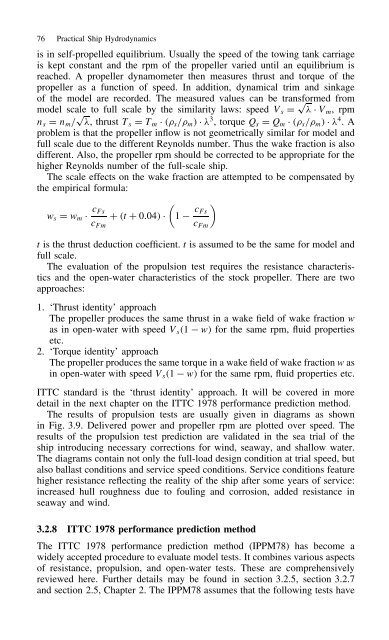Practical Ship Hydrodynamics
Practical Ship Hydrodynamics
Practical Ship Hydrodynamics
Create successful ePaper yourself
Turn your PDF publications into a flip-book with our unique Google optimized e-Paper software.
76 <strong>Practical</strong> <strong>Ship</strong> <strong>Hydrodynamics</strong><br />
is in self-propelled equilibrium. Usually the speed of the towing tank carriage<br />
is kept constant and the rpm of the propeller varied until an equilibrium is<br />
reached. A propeller dynamometer then measures thrust and torque of the<br />
propeller as a function of speed. In addition, dynamical trim and sinkage<br />
of the model are recorded. The measured values can be transformed from<br />
model scale to full scale by the similarity laws: speed Vs D p Ð Vm, rpm<br />
ns D nm/ p 3 4 , thrust Ts D Tm Ð ⊲ s/ m⊳ Ð , torque Qs D Qm Ð ⊲ s/ m⊳ Ð .A<br />
problem is that the propeller inflow is not geometrically similar for model and<br />
full scale due to the different Reynolds number. Thus the wake fraction is also<br />
different. Also, the propeller rpm should be corrected to be appropriate for the<br />
higher Reynolds number of the full-scale ship.<br />
The scale effects on the wake fraction are attempted to be compensated by<br />
the empirical formula:<br />
ws D wm Ð cFs<br />
� �<br />
cFs<br />
C ⊲t C 0.04⊳ Ð 1<br />
cFm<br />
cFm<br />
t is the thrust deduction coefficient. t is assumed to be the same for model and<br />
full scale.<br />
The evaluation of the propulsion test requires the resistance characteristics<br />
and the open-water characteristics of the stock propeller. There are two<br />
approaches:<br />
1. ‘Thrust identity’ approach<br />
The propeller produces the same thrust in a wake field of wake fraction w<br />
as in open-water with speed Vs⊲1 w⊳ for the same rpm, fluid properties<br />
etc.<br />
2. ‘Torque identity’ approach<br />
The propeller produces the same torque in a wake field of wake fraction w as<br />
in open-water with speed Vs⊲1 w⊳ for the same rpm, fluid properties etc.<br />
ITTC standard is the ‘thrust identity’ approach. It will be covered in more<br />
detail in the next chapter on the ITTC 1978 performance prediction method.<br />
The results of propulsion tests are usually given in diagrams as shown<br />
in Fig. 3.9. Delivered power and propeller rpm are plotted over speed. The<br />
results of the propulsion test prediction are validated in the sea trial of the<br />
ship introducing necessary corrections for wind, seaway, and shallow water.<br />
The diagrams contain not only the full-load design condition at trial speed, but<br />
also ballast conditions and service speed conditions. Service conditions feature<br />
higher resistance reflecting the reality of the ship after some years of service:<br />
increased hull roughness due to fouling and corrosion, added resistance in<br />
seaway and wind.<br />
3.2.8 ITTC 1978 performance prediction method<br />
The ITTC 1978 performance prediction method (IPPM78) has become a<br />
widely accepted procedure to evaluate model tests. It combines various aspects<br />
of resistance, propulsion, and open-water tests. These are comprehensively<br />
reviewed here. Further details may be found in section 3.2.5, section 3.2.7<br />
and section 2.5, Chapter 2. The IPPM78 assumes that the following tests have
















